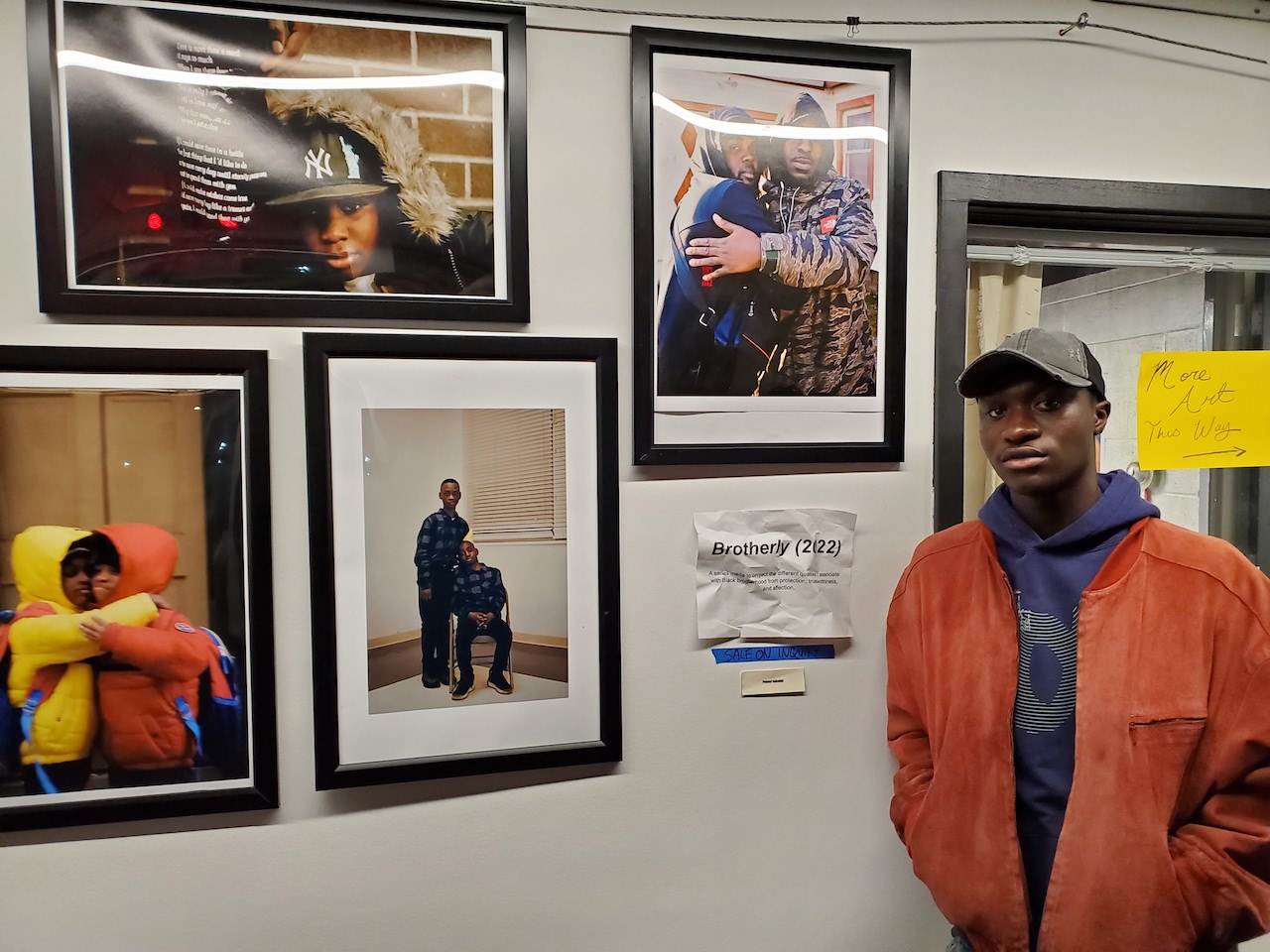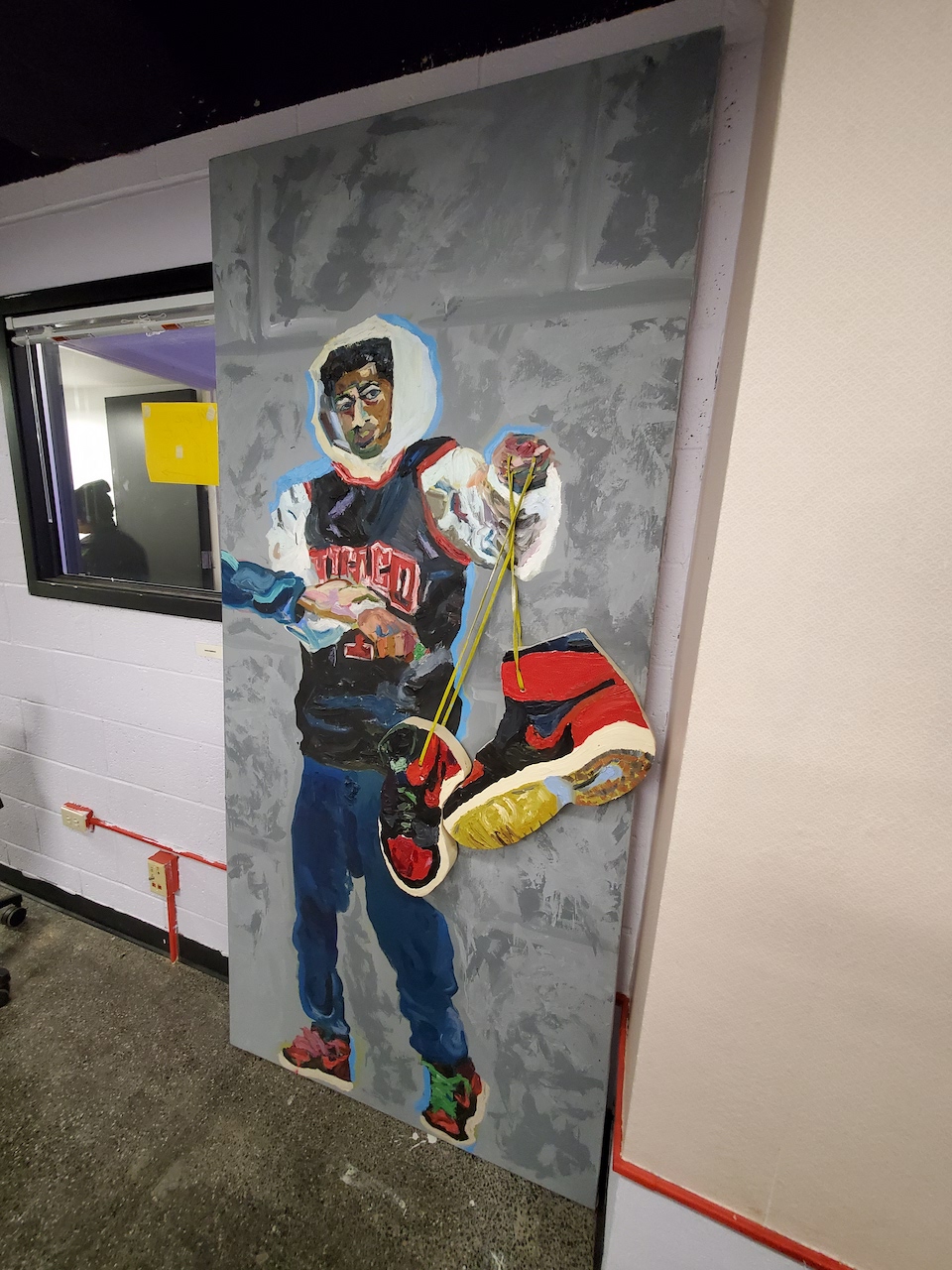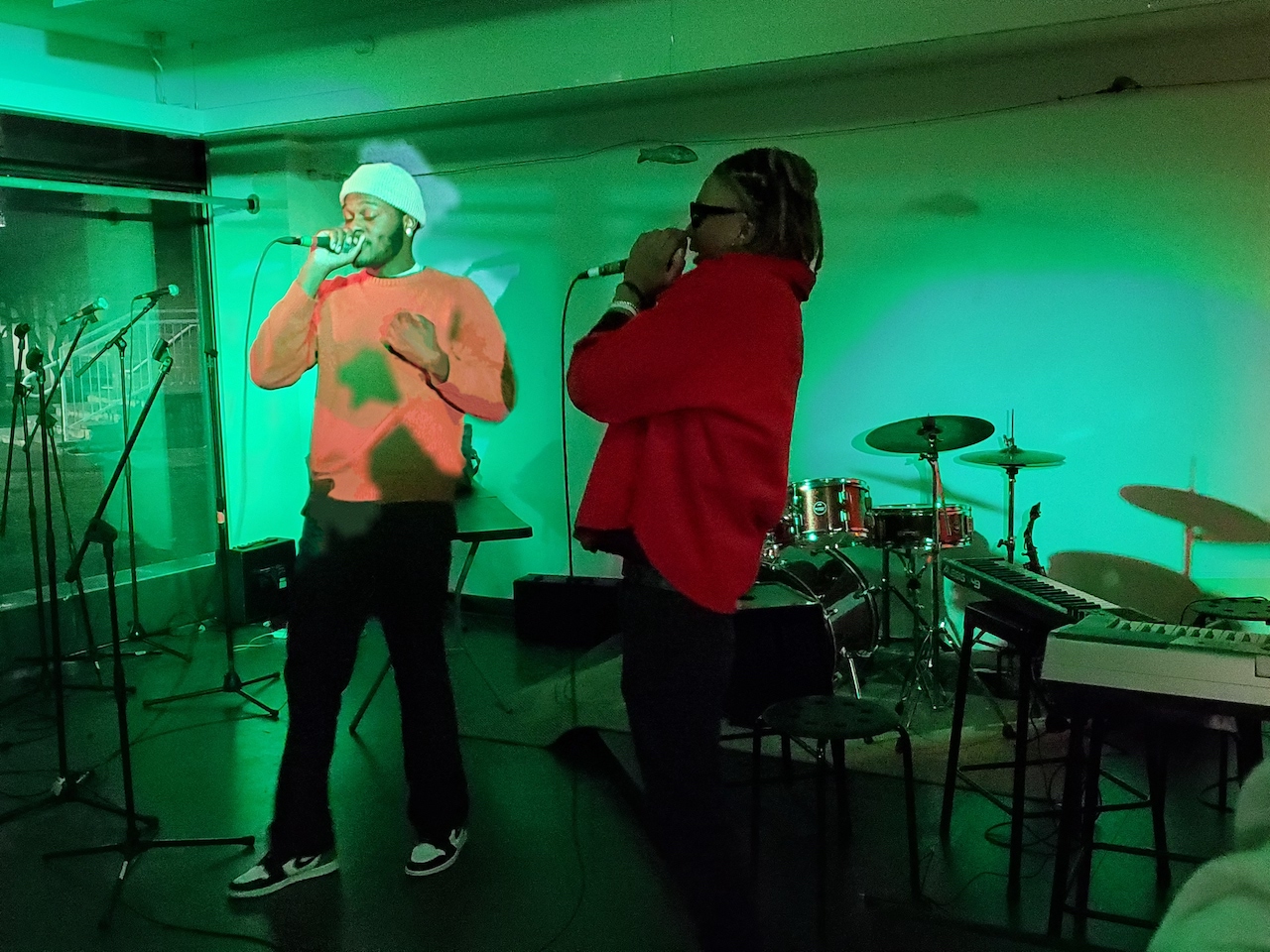
On the evening of Friday, Feb. 24, students filled the Workshop—the student-run creative space in the basement of Hewitt 8—with a wide array of audiovisual expressions for Eclipse, a showcase of Black student artists. As one of the many events commemorating Black History Month across the University, musician Neo Fleurimond ’24 and visual artist Jolexis DeJesus ’23 organized Eclipse with the goal of bringing together student creatives from across artistic realms.
“I actually had this idea for a pretty long time,” DeJesus said. “Something I always would think about is that there was no space where I would see artists just showing their work besides the senior thesis exhibitions. The only space where that really occurs is in Zilkha. That’s very formal. We were very much thinking about how to bring the actual experience of being a visual artist who would be in a gallery to these Black students who aren’t given [access] to do so.”
Fleurimond elaborated on the goals of the event, explaining that Eclipse aimed to provide a space for Black artists across a variety of mediums.
“It’s difficult being a Black creator because it’s hard finding a space where people look like you,” Fleurimond added. “So my vision was, okay, if we can do this from a music aspect, we can definitely extend this to other branches such as dance, such as art. Seeing how that can bring together a community that from my perspective oftentimes seemed very competitive. It was more so we were competing against each other rather than trying to thrive with each other.”
Fleurimond and DeJesus explored a wide range of venues on campus to hold Eclipse. They initially looked into hosting the event at the Zilkha Gallery, Beckham Hall, and the Daniel Family Commons on the top floor of the Usdan University Center, but found themselves unable to book these spaces. Eventually, working with the Black Student Union (Ujamaa), they successfully booked the Workshop, and their event became the first to be hosted in the Workshop in over a year, following a period of disuse.
While Eclipse’s first hour saw light attendance, with students trickling in as artists affixed their works to the walls of the Workshop and the event’s musical performers carried out their sound check in the main room, the event picked up speed after 8 p.m., as more attendees filled the space and contributed to an overall upbeat atmosphere. While the student artists explained their works to curious onlookers, their friends showed up to cheer them on.
An array of colorful multimedia works by DeJesus, spread out across a table and a wall, were the first artwork to greet onlookers near the Workshop’s entrance.
“I do a lot of painting on mixed media objects,” DeJesus said. “The studio art major is one of the most expensive majors, for which there’s very little financial support. Because of that, I have to get really creative with my work. So a lot of the work that I do, I use materials that I find on the street. I use images that I find on the street. I literally will create pigments out of dirt and other things.”
As DeJesus incorporates everyday objects into her work, she also hopes to link her art to everyday life and create connections between herself and her audience.
“A lot of my work is about me being a Hispanic woman on this campus and how it feels to be Afro-Latina and have these intersectionalities and to mainly show my work to an audience who does not look like me,” DeJesus said. “My work is about taking your story and bringing it to life and just allowing people to resonate with that if they choose to…. I’m just trying to use signifiers that I think most people could relate to in the everyday.”

Perpendicular to DeJesus’s display, a group of framed photographs taken by Pelumi Sokunbi ’25 hung on the wall. The work belongs to a series entitled “Brotherly.” Sokunbi explained that the photos intend to visualize the variety of emotional ties that can exist between Black boys and men, from an affectionate hug between two young friends to a bond of protection expressed as a knowing look between two grown adults.
As attendees headed through a doorway, the long hallway to their right featured a wide array of artworks displayed on tables and walls. A number of colorful portrait-style illustrations by Kailer Brothers ’25, captioned “BLACK FACES, BLACK SPACES,” sat on a table. Pinned to a corkboard on a wall further down the hall, photos by Abbi Abraham ’23 contained high-contrast black-and-white images. At the end of the hallway, mounted on the doors leading out of the Workshop, were large, striking paintings by Cameron Williams ’23. The adjacent corner contained a trio of brightly colored works by Kaina Remy ’24, two mounted on the walls, with a third sitting on a stool.

The third room displayed a group of larger multimedia works. A life-size painting by recent WesCeleb Leevon Matthews ’23, also among the night’s musical performers, leaned against one wall. A striking piece by Matty Shields ’25, consisting of two signs bearing the large print text “LAND OF LIBERTY” and “1826 1.5 MIL SLAVES” sat on the other side of the room. The work also included a pair of headphones. When I put them on, I heard a clip of MSNBC anchor Joy Reid discussing the myths behind Thanksgiving and its link to colonialism, then an incredulous response by conservative commentators on Fox News. This audio accompaniment exemplified the piece’s overall reframing and commentary on American history and culture.
Two video pieces by Keren Mikanda ’25 played on a large television on one side of the room. Mikanda explained that the works were originally assignments done for classes. One featured cut-together scenes from coming-of-age films commenting on ideas of youth as presented in media. Another, filmed in black and white with a boxy aspect ratio, showed scenes from Mikanda’s everyday life at the University in a style reminiscent of a vlog. On the other side of the room, large wall-mounted photos taken by Shasekh Augustin ’23 showcased deeply saturated portraits, a sign designating the group as the “FINITE COLLECTION.”
At around a quarter to 9, the evening’s musical performances kicked off. A crowd congregated in the main room as Fleurimond gave opening remarks.
“Matriculating to this university, there wasn’t many people who looked like me in places of creativity,” Fleurimond said. “[Here,] I found a space with people who look just like me and have the same experiences as me. It’s really beautiful.”
Matthews took the stage as the first performer of the evening, thanking Fleurimond for creating a space for Black creatives on campus and linking it to his own work founding the Mic Check concert series.
“We’re on the same field playing different positions, so thank you for that,” Matthews said.

Matthews rapped through his set with a laid-back confidence, assuredly engaging the crowd. Even in the midst of sound issues, which forced him to switch from a wireless to a wired microphone midway through, Matthews carried on. A duo of rappers, TrueyJudes (Judeley Jean-Charles ’24) and LorWood (Langston Woody ’25) were the next to take the stage after Matthews. Jean-Charles took on double duty, serving as both rapper and DJ, while Woody took center stage, commanding the audience from behind his striking dark sunglasses with catchy, Auto-Tune-inflected bars. After the pair left the stage, the next performer, Danae Williams ’25, lit up the crowd with an energetic dance routine performed to Teyana Taylor’s “Rose in Harlem.”
After a brief intermission, the night’s final performers, Black Raspberry, took to the stage. A 27-piece ensemble led by Fleurimond on saxophone, the group boasts a full range of vocalists and instrumentalists.
Black Raspberry’s alto vocalists are Amah Assoumou ’26, Kyla Danquah ’25, Brianna Johnson ’24, Cassidy McDonough ’23, Mikanda, Christina Onuzuruike ’24, Kelsey Onyia ’26, Kayla Penza ’23, and Grace Warner-Haakmat ’24. The group’s soprano vocalists are Abraham, Lauren Berthoumieux ’25, Tiah Shepherd ’23, and Remy. The tenor vocalists are Kofi Agyei-Yeboah ’25, Ellis Carter ’25 (who also plays trumpet), Michael Fadugbagbe ’25, Ayer Richmond ’24, Spencer Turner ’25, and Woody.
Black Raspberry’s instrumentalists include a horn section made up of Fleurimond on saxophone, Xavier Samuel ’26 on alto saxophone, and Jalen Richardson ’25 on the trumpet. Sokunbi serves as the group’s drummer, Brothers plays the bass guitar, and Jazmin Davis ’24 plays the electric guitar. Jean-Charles and Mirembe McDuffie-Thurmond ’25 play piano, though in this confined setting, they opted for keyboards. Notably, many of the members of Black Raspberry are also visual artists or musical artists whose work was showcased elsewhere in Eclipse.
“[Black Raspberry has] been a wonderful, safe, and comforting environment for Black musicians,” Fleurimond said. “At the end of the day, we like making music, we like playing music and we like sharing music and that’s what we want to continue on this campus.”
With an energetic, harmony-rich sound flowing from Black Raspberry’s many members, they played an exciting set that included both recognizable covers, such as Childish Gambino’s “Redbone” and Bell Biv DeVoe’s “Poison,” as well as original work by Fleurimond. As the performance crept past the 10 p.m. end time, Fleurimond wrapped things up and thanked the attendees for coming. Black Raspberry continued to jam as students spilled out into the cold night.
“One of the things that really made me appreciate [Black Raspberry] more is the love that we had for each other and the love that the Black community shows for us,” Fleurimond said. “But any support that we get from any community, white, marginalized, or, any POC group, we love to see everyone because that lets us know that the love that we have for our music is shared.”
When asked about the takeaway she wanted those who came to Eclipse to share, DeJesus replied succinctly.
“Support Black artists,” she said.
“I want this event to promote kinship and true support,” DeJesus continued. “I just really encourage people to really try to visualize and feel the message that they’re getting from their Black peers. Ultimately, this is a PWI [predominantly white institution] and our experience is very marginalized and isolated. And if you do not have this identity, the least you can do is show up and ask, or at least be a witness in order to try to get to understand how it feels.”
Oscar Kim Bauman can be reached at obauman@wesleyan.edu.


Leave a Reply